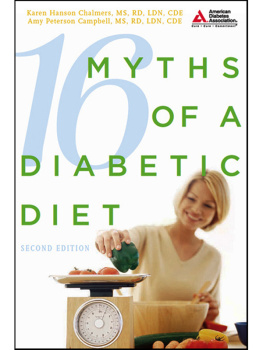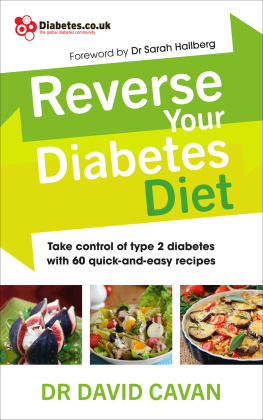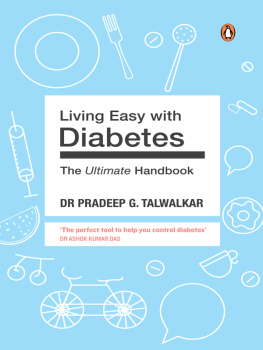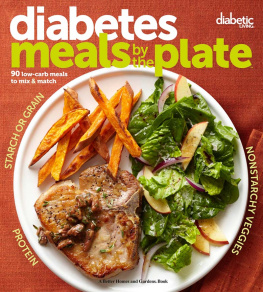
Director, Book Publishing, Robert Anthony; Managing Editor, Book Publishing, Abe Ogden; Editor, Greg L. Guthrie; Production Manager, Melissa Sprott; Composition, American Diabetes Association; Cover Design, Jody Billert/Design Literate, Inc.; Printer, United Graphics Incorporated.
1999, 2007 by the American Diabetes Association, Inc. All Rights Reserved. No part of this publication may be reproduced or transmitted in any form or by any means, electronic or mechanical, including duplication, recording, or any information storage and retrieval system, without the prior written permission of the American Diabetes Association.
Printed in the United States of America
1 3 5 7 9 10 8 6 4 2
The suggestions and information contained in this publication are generally consistent with the Clinical Practice Recommendations and other policies of the American Diabetes Association, but they do not represent the policy or position of the Association or any of its boards or committees. Reasonable steps have been taken to ensure the accuracy of the information presented. However, the American Diabetes Association cannot ensure the safety or efficacy of any product or service described in this publication. Individuals are advised to consult a physician or other appropriate health care professional before undertaking any diet or exercise program or taking any medication referred to in this publication. Professionals must use and apply their own professional judgment, experience, and training and should not rely solely on the information contained in this publication before prescribing any diet, exercise, or medication. The American Diabetes Associationits officers, directors, employees, volunteers, and membersassumes no responsibility or liability for personal or other injury, loss, or damage that may result from the suggestions or information in this publication.
 The paper in this publication meets the requirements of the ANSI Standard Z39.48-1992 (permanence of paper).
The paper in this publication meets the requirements of the ANSI Standard Z39.48-1992 (permanence of paper).
ADA titles may be purchased for business or promotional use or for special sales. To purchase more than 50 copies of this book at a discount, or for custom editions of this book with your logo, contact Jewelyn Morris, Special Sales & Promotions, at the address below, or at JMorris@diabetes.org or 703-299-2085.
For all other inquiries, please call 1-800-DIABETES.
American Diabetes Association
1701 North Beauregard Street
Alexandria, Virginia 22311
Library of Congress Cataloging-in-Publication Data
Chalmers, Karen.
16 myths of a diabetic diet / Karen Hanson Chalmers, Amy Peterson Campbell.2nd ed.
p. cm.
Includes index.
ISBN 978-1-58040-287-3 (alk. paper)
eISBN 978-1-58040-374-0
1. DiabetesDiet therapy. 2. Medical misconceptions. I. Campbell, Amy Peterson, 1964- II. Title. III. Title: Sixteen myths of a diabetic diet.
RC662.C45 2007
616.4620654dc22
2007021343
eISBN: 9781580403740
To our patients, friends, and family members
with diabetes, who have taught us so much about
what it means to live with diabetes.
To my husband, Rob. As a person who has lived with diabetes
for more than 30 years, youre an inspiration and role model for
children and adults with diabetes. Thanks for all that you do.
A.P.C.
To Kara, Nate, and Erin: You have all demonstrated
incredible strength, support, and courage during challenging
times. Thank you. To Gabriella: A strong and beautiful
gift who has brought joy into our lives.
K.H.C.
CONTENTS
As a person with long-standing type 1 diabetes (almost 54 years at this writing), I have learned a good deal about this disease over the years. My information has come from doctors, nurse educators, dietitians, family members, and friends. It has come in the form of books, conversations, magazine articles, and, more recently, online articles. And it has come from practicing the art of living with diabetes. Probably the most important thing I have learned in all this time is that I can always learn more.
When I was diagnosed at the tender age of four, diabetes care was very different than it is now. I was taught to categorize and weigh all of my foods (carbs, proteins, and fats alike) by my father, a scientist and professor. He and my mother learned all they could from my doctor at the Joslin Diabetes Center in Boston, Dr. Priscilla White. In addition to diet planning and measuring, our tools included metal and glass syringes with separate metal needles that regularly became dull. My father tested the needles on his thigh as he sharpened them! All the injection equipment had to be kept in a special sterile bath between uses. My parents, and soon I, tested my urine for sugar several times a day using an eye dropper and a tablet that boiled and changed colors in the test tube. In short, we had none of the wonderfully liberating tools of today: glucose monitors, insulin pumps, glucose sensors, carbohydrate counting, the glycemic index, detailed food labels, and a half-century of research and studies aimed at understanding and improving our lives.
I first heard some of the diet myths described in this book when I was in my early twenties, while I attended a class at the Joslin Diabetes Center. Among the students were a number of newly diagnosed patients. I answered their numerous questions and misconceptions with what I hoped were accurate, even encouraging, anecdotes of my own struggles to balance food with insulin and with energy output (both physical and mental). I was horrified to learn that some people believed I could not eat anything with sugar in it! I have always loved fruits and vegetables and could not imagine living without them, let alone without the many varieties of rice, pasta, potatoes, corn, breads, and the occasional ice cream or cookie. I remember the mother of a five-year-old child asking me whether her daughter could ever again live a normal life and eat normal food. I hope she learned from the classes (and perhaps from me) that she not only could live a long, healthy, normal life, but most likely would.
Through the years I have encountered people living in the diabetes Paleolithic period, as I call it. They seem to carry the remnants of a genetic memory of a time before insulin was discovered and when having type 1 or juvenile diabetes was a death warrant: you could eat no carbohydrate because it would raise your blood sugar, which, without insulin, would slowly take away your life; therefore, starvation caused your early demise instead. It wasnt a pleasant choice, obviously. Comments from these diabetes dinosaurs, such as, Oh, youre diabetic? My grandmother died of that. She ate too much sugar, always sent me into training mode, and I would carefully explain how sugars are a natural part of many foods that we can and should eat, how we have to measure our food intake against our insulin doses and exercise, and how life with diabetes is a balancing act rather than a process of restriction or denial. Sometimes, the person listened politely, and I could almost see the information trickling out the other ear!
But for every diabetes dinosaur I have met, I have known several modern-day creatures: people who are genuinely interested in the subject, open minded, and pleased to ask questions and to learn more about life with diabetes. I hope you are that kind of personwith or without diabetesbecause Amy Campbell and Karen Chalmers have here presented a wealth of information to live by. Their presentation is conversational, well organized, and chock full of comforting facts about eating healthfully.
Next page












 The paper in this publication meets the requirements of the ANSI Standard Z39.48-1992 (permanence of paper).
The paper in this publication meets the requirements of the ANSI Standard Z39.48-1992 (permanence of paper).